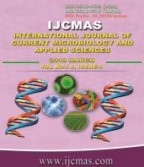


 National Academy of Agricultural Sciences (NAAS)
National Academy of Agricultural Sciences (NAAS)

|
PRINT ISSN : 2319-7692
Online ISSN : 2319-7706 Issues : 12 per year Publisher : Excellent Publishers Email : editorijcmas@gmail.com / submit@ijcmas.com Editor-in-chief: Dr.M.Prakash Index Copernicus ICV 2018: 95.39 NAAS RATING 2020: 5.38 |
The agricultural sector faces daunting challenges because of climate change, particularly amidst increasing global water scarcity, which threatens irrigated lowland rice production. By 2025, 15-20 million ha of irrigated rice is estimated to suffer from some degree of scarcity. Rice systems provide a major source of calories for more than half of the world’s population; however, they also use more water than other major crops. Irrigated lowland rice not only consumes more water but also causes wastage of water resulting in degradation of land. In recent years to tackle this problem, many methods of cultivation have been developed. Among the different methods of water-saving irrigation, the most widely adopted is Alternate Wetting and Drying (AWD) irrigation method. AWD technique has developed by IRRI in partnership with national agricultural research agencies in many countries. Practical implementation of AWD was facilitated using a simple tool called a 'field water tube'. It is an irrigation practice of introduction of unsaturated soil conditions during the growing period that can reduce water inputs in rice without compromising yields. AWD technique can save water requirement up to 20-50% and improve water use efficiency besides reducing greenhouse gas emissions by 30-50%. which have impact on climate change. However, AWD has not been widely adopted, in part, due to the apprehension of yield reductions and hence demands greater efforts from researchers and extension workers. Safe AWD threshold level found to be 5-15cm water fall below surface in field water tube which needs to be validated in different soil types and different climatic conditions. Proper management of water in safe threshold is the foundation of AWD to realize potential yield while saving water.
 |
 |
 |
 |
 |